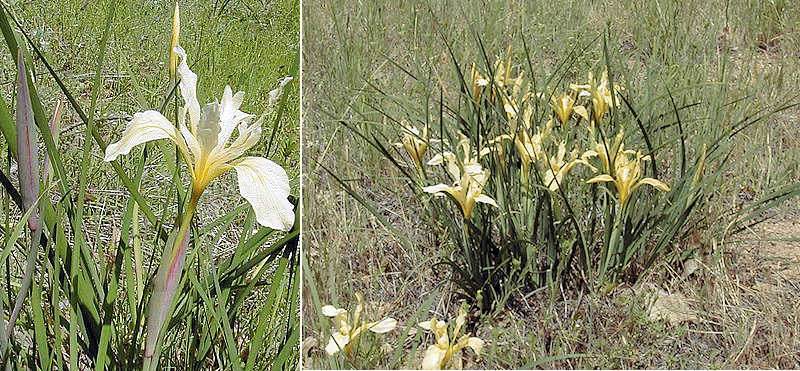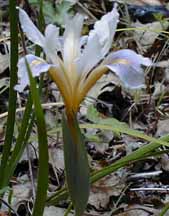Wild PCN iris - long tube group (5 species), spathes enclose ovary:
5. Fernald's iris - Iris fernaldii

Photos: (L): Jack London St. Park, Sonoma County; (R) Bartlett Springs, Lake County, California. Steve Ayala

Range: Central California Coastal Ranges; 50 to 2,000 feet elevation.
Original material: 5 miles west of Petrified Forest, Santa Rosa-Calistoga Highway, Sonoma County, California 1937.
Key identifying features:
- Long floral tube, 1½ to 3 inches.
- Top of tube funnel-shaped, petals joined above bowl in a kind of throat before separating.
- Spathes broad, enclose ovary and most of tube.
- Plants form individual stems.
- Bases of stems, leaves and spathes often show a red wine color tint.
Flower color: Rich to pale yellow, cream, white or pale lavender petals with a yellow signal spot and darker veins.
Habitat: Moderately to mostly shaded inland woodlands, usually in loose, duff-covered soil. Plants usually singular, but small clumps can form when seeds of several generations fall in the same patch.
Name: By Robert C. Foster, after Merritt Lyndon Fernald, a respected Harvard University professor of botany.
Comments: In colorful magazines promoting California's wine industry, Iris fernaldii is sometimes called the "little yellow wild iris". "Wine country iris" would be equally appropriate, since its distribution coincides closely with the best wine producing regions in the central coastal ranges.
Evidently, unique soil and climate conditions favor both Fernald's iris and good vineyard crops. The difference is that the little yellow wild iris lives on the cool, shaded floor of the same oak forests that vineyard owners clear cut so their grapes can grow in full sun.

In published reports, Fernald's iris and Iris macrosiphon are sometimes confused. The yellow, cream or white flower color, a pink or reddish tint on the spathes, stem and base of the leaves, a long floral tube that opens gradually above the bowl before dividing into individual petals, and a clear habitat preference for rich humus soil in shady forests are typical fernaldii traits. Coastal Iris macrosiphon prefers a more exposed, sunny environment; its petals and sepals separate directly along the edge of the bowl-like swelling at the top of the floral tube.
Fernald's iris crosses readily with other native irises that live nearby, so traces of these other species often appear in local fernaldii populations (especially in edge or marginal habitats). Plants of mixed parentage - like this macrosiphon x fernaldii hybrid with pale lavender petals shown on the right - tend to prefer more sun. Genes from I. fernaldii might be the source of the yellow color of some of the natural Pacifica hybrids, like the "Santa Cruz iris", the "Marin iris" and yellow I. macrosiphon.